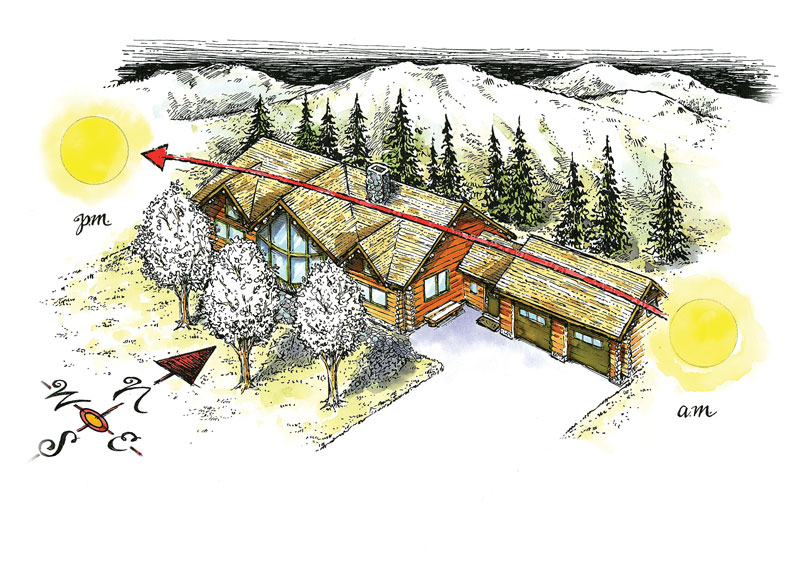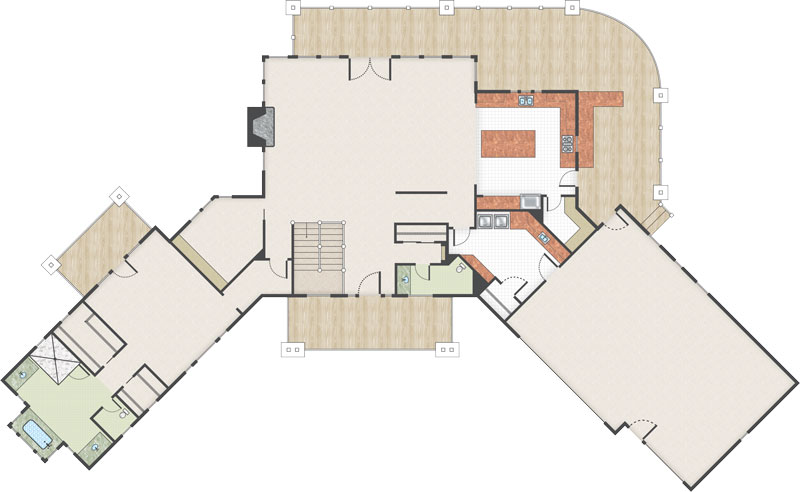While it’s probably the most involved of all the stages of home building, the design phase can also be the most creative and rewarding. Now’s your chance to design a living space that matches your family’s unique lifestyle.
Most people think of designing their new home as the fun part of the process. And it should be. But designing a home that fits your family’s needs, site, climate, budget and lifestyle also takes time and research. Even if you plan to work with an architect or work off a stock floor plan, chances are good that you’ll want to scratch out some design ideas on your own first.
Your first step is to determine your budget. Don’t make the mistake of designing a home you can’t afford to build. Good design and realistic budgeting go hand in hand. A visit to a lender can give you a rough idea of how much money you can borrow. As the design process progresses and you create a more refined drawing of your home, you can begin estimating your costs. With your budget clearly in mind, you’re ready to gather information on two of the other variables — site and climate — that affect the design of all successful homes.
Know Your Building Site
Your home will be a much more enjoyable place to live if it’s designed to work in harmony with its surroundings. You can easily catalog your site’s natural features by bringing copies of your site plan or property survey with you whenever you visit your property. Note the slopes and planes of your site; this will help you better plan the elevations of your house. Look for the best views so you can plan for windows or decks to face those directions. Study the sun’s orientation so that you can plan to capture free energy in the winter, and note the existing tree cover that can shade the house in the summer months. Use these natural features of your site to their full potential.
Try to visualize your home on the site as well. You may want to bring stakes and string and mark off probable locations. It you anticipate adding on to your home in the future, position your home with that in mind.
It’s a good idea to hire a civil engineer or land surveyor to prepare a plan of your building site. A site plan includes such valuable information as property lines, building set-backs, easements and rights of way. A site plan also maps out the location of trees, hills, ponds or streams and any other significant land forms. And a thorough site plan will also locate roads (so you can determine access to your site and potential noise) as well as buildings on adjacent sites (including windows and outdoor decks and balconies).
You’ll need the information a site plan provides to properly locate a septic system, properly position solar panels or a swimming pool, plan a walk-out basement and much, much more. A site plan provides the environmental base of information for your home’s design. Chances are, the first problem you encounter because you saved money by avoiding a site survey will cost more than what you saved.
Some people camp out on their site to get a better feel for it. Before you become too attached to the idea of building your house right next to that babbling brook, however, you need to check with your local building department. You may be constrained by rules about where on the property you may build.
There may be other restrictions that apply to your building plans. If you’re building in a subdivision, your project may be subject to neighborhood covenants, some of which may regulate a home’s exterior style. Take the home to research all possible restrictions before you start to design your home.
Design for Climate
When a home is designed without taking the climate into consideration, it can’t provide for the comfort of the family that inhabits it. Remember that taking advantage of your site’s natural features — the solar orientation, prevailing wind patterns and natural tree cover — will make your home much easier to heat and cool than if you ignore the benefits of good site planning.
In colder climates, designing passive solar features into your home will boost its energy efficiency. Let the sun enter through vertical windows oriented to the south or west; a tile floor or brick fireplace will help absorb the sun’s warmth. In warmer climate zones, however, be sure to incorporate deep roof overhangs to conceal your home’s windows from the hot overhead sun.
Gather Your Design Ideas
Once you’ve researched your site and climate, you’re ready to begin your design wish list. Go through home-design magazines and websites (like this one!) and save photos that show something you particularly like — a built-in entertainment center, an island work station in the kitchen or a stone fireplace, just to name a few. Also save pictures of exterior home styles, roof designs, window styles, landscaping, patios and decks — anything that catches your eye.
Think not only about the types of spaces you’d like to have in your home, but how you’d like those spaces, and your home as a whole, to look and feel. Home interiors can be designed in a range of styles and moods from contemporary to traditional, open and spacious to cozy and snug, elegant to casual. Visit model homes and home shows. When in the homes of friends or family, make mental notes of what appeals to you or what might not work for your family’s lifestyle.
Room-by-Room Design
A successful home is one that works well for the people that live there. Every home needs spaces to serve different functions. Consider some of the following areas when planning your home:
Cooking & Eating Areas
Today’s kitchens often serve as the hub of the home, overlooking a great room or linking a family room with outdoor living spaces. Consider whether you would prefer a kitchen that is open to or part of the family room or dining area, or a more traditional kitchen in its own space. How many cooks will be working at one time in your kitchen? Consider including an extra sink or additional counter space in your design. What type and size appliances will be included in the kitchen? Plan counter and work space accordingly. Do you prefer a pantry or cabinets for storing food and dishes? Do you need an area to store recyclable materials? Will you need a formal dining room? Or just enough room for a table and chairs in the kitchen? A breakfast bar in the kitchen is handy for families on the go who often eat meals at different times. Do you prepare and eat a good number of your meals outdoors? A sun space, screened porch or deck off the kitchen are all options for informal dining.
Sleeping Spaces
Think about the number of bedrooms your family needs. Will children need separate rooms or will they be sharing rooms? One popular plan is to have younger children share a bedroom that is connected by a bathroom or a closet to a playroom, which can then become a separate bedroom when the children grow older and need more space and privacy. Do you envision a master bedroom suite with his and hers closets? An oversized tub or a sitting area? Should the master bedroom be on the first or second floor? Do you want it to be near the children’s rooms or away from them? Small children may need to be near you while adolescents would probably prefer some distance. Do you anticipate having regular or long-term houseguests? Rather than simply planning a guest room into your floor plan, consider a guest suite with a bedroom, bath and sitting area.
Gathering Spots
Every house needs one central gathering area to serve as the heart of the home and to provide space for entertaining. A great room can accommodate a range of activities, especially if it’s designed to let traffic flow between the kitchen, dining room and outdoor living areas. You may desire a more private gathering space, such as a sectioned-off den or more formal living room, or one for a more specific activity such as a game room, TV room or home gym. Get the entire family in on discussing the common gathering area, and don’t be afraid to let your imagination run wild.
Personal Privacy Areas
Everyone needs private time, so make sure your home includes a few spaces to retreat to for peace and quiet. Private spaces can take many shapes: a quiet corner for reading or study; a den or office where you can work from home; a sewing room or studio for hobbies. Other spaces you need to consider include bathrooms, laundry and utility rooms, storage areas and outdoor living areas. Be as complete as possible when considering your needs for today and in the future. Remember that with thoughtful planning today, a properly designed children’s wing can become a guest suite for a visiting college student and, after graduation, the perfect in-home office for a semi-retiree.
Create Your Plan
Now it’s time to start sketching your plan. While designing, be sure to consider elements such as sun, views, noise level, privacy, outside access, traffic patterns, etc. Don’t be discouraged if you find that adding in one item from your wish list cancels out another. Compromises are inevitable, although more often due to the limits of budget rather than design.
For example, it may not be possible to design a ground floor master bedroom with vaulted ceilings if you need to use the story above the bedroom for living space. On the other hand, what may at first appear to be a design conflict could lead to a creative solution. So, in this situation, instead of building an extra bedroom on the second story for a study you need, building an open loft study above the master bedroom would allow you to retain those vaulted ceilings.
While bedrooms that soar to the rafters are just some of the magnificent design features possible with timber framing, these wide-open areas may leave you with few places to hide your home’s mechanical systems (electrical, plumbing, heating, ventilating and air conditioning). Take this into account during the design phases by clustering and stacking your plumbing areas, restricting them to one or two areas of the home. Another good idea is to stack closets from one floor to the next to provide hidden space for plumbing, pipes and ductwork.
Work With a Pro
Before you get too far along with your design, you will want to enlist the services of an expert. The aid of a timber frame or design professional may help you fine tune your design ideas or catch potential design problems in the early stages. A professional also can help point out ways to save money in one area, which may allow you to indulge somewhat in another area. And a professional versed in timber frame design will be extremely helpful in integrating your floor plan with a frame plan so that the two work in harmony.
Nearly every room in your home will be affected by the posts and beams in your frame, so the earlier you begin integrating your home’s floor plan with a frame plan, the better the chances that your frame will enhance your floor plan. The frame plan shouldn’t rule the floor plan, but it should be used to its full potential. Depending on the complexity of your home, the design phase can take from several months to a full year to complete. You’ll then be ready to hire a general contractor and prepare to build your new home.
6 Planning Tips From the Pros
Creating a floorplan can be one of the biggest challenges you’ll ever face. That’s why we asked members of the timber-home industry to share some of their best advice for building a masterpiece. Here’s what we learned:
1. Tell the truth.
You’ll bear your soul in the relationship you have with a designer, so be ready to be open and honest — especially when it comes to your budget. The initial design probably will be over your target budget, but that’s okay. Start with the dream and then rework it as you go.2. Go with the flow.
Think of the design in terms of movement through the plan, and break it into three elements: pathways, transitions and places. Create interesting walkways or hallways that lead to grand spaces. This allows even the simplest plan to have rich details.3. Mind the slope.
Terrain — especially slopes — can be deceiving, because your eye follows the grade. So when you visit your home site, take a carpenter’s level, string line and measuring tape. You may find you’ll need a ladder to envision your view from the edge of the great room.4. Think about privacy.
One of the greatest strengths of a timber home is its open floorplan. But if your home isn’t designed well, this openness can lead to a lack of privacy. Work with your designer to ensure that some rooms are tucked away from public areas.5. Beware of wasted space.
Reduce hall lengths and large areas that don’t serve any purpose. For every room in a home, avoid long narrow spaces; they’re hard to furnish and hinder traffic flow. Also, place doors toward the corners of rooms rather than the center, as this provides more usable space. When you’re drawing your rough design, also imagine the direction of the door swing, and visualize which way is the most practical.6. Create a comfortable entryway.
The minimum size for a main entrance is 8 feet by 8 feet. This area should provide enough space for your family or guests to comfortably enter and remove their coats and shoes. Even though a closet is located in this area for convenience, it’s important to remember that it doesn’t have to be your main coat storage.














